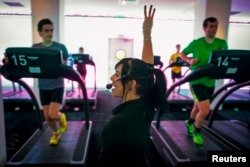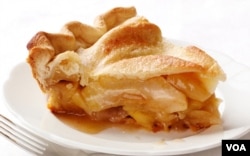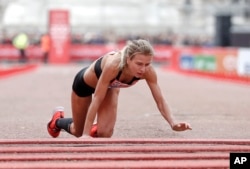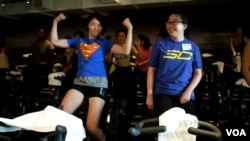Do you like to “work out?”
What do you do to “warm up” for exercise?
Do you enjoying walking, dancing, or running?
In today’s Everyday Grammar, we will look at how we can express ways we exercise. You will learn about common phrasal verbs to describe our actions and gerunds for kinds of exercises.
Let’s begin with phrasal verbs.
Phrasal verbs
Phrasal verbs have a verb and either a preposition or an adverb called a particle. A particle is a short word. Phrasal verbs can be made up of one particle or two. A phrasal verb has a meaning different from that of the verb alone. Phrasal verbs can often be separated from the particle by a noun or pronoun.
Some of the most common exercise phrases in English are phrasal verbs.
Let’s take a look at some of them.
“Work out” is a transitive verb. meaning to do physical exercise to make your body strong or healthy. A transitive verb can take a direct object.
She works out her legs every day at the gym.
“Warm up” means to prepare for exercise by doing light exercise to increase your heart rate and warm your body.
Emily warms up by walking on the treadmill.
“Cool down” is the opposite of warm up. After intense exercise, you need to cool down your body to let your heart rate decrease naturally.
I like to cool down by stretching my muscles.
“Work off” means to get rid of stress, emotions, energy, or even food by doing physical activity.
I need to work off that apple pie I had at Thanksgiving. Let’s go to the gym!
I had such a stressful day at work, I can’t wait to work that off at dance class tonight!
“Try out (for)” means you compete for a spot on a team.
Tatiana tried out for the football team in August. She will play her first game this weekend!
“Pass out” means you feel sick and fall down or faint.
If I don’t drink enough water before I do an intense workout, I always feel like I’m going to pass out.
She passed out near the end of the finish line because she was dehydrated.
“Give up” means that you stop what you are doing and do not continue.
He had to give up playing basketball last year after he hurt his knee.
Gerunds
Gerunds are formed from verbs, but they work like a noun in a sentence. We use the ending -ing to create a gerund. Gerunds express actions or states of being. There are several gerunds that we use to express kinds of exercise.
For example, “walking” is a gerund.
We take the base form of the verb and add -ing.
Walk + ending -ing = walking
Walking is one of the best activities for your health.
Other common gerunds for working out include:
“Jogging” is like running but with an easier pace.
Tyler enjoys jogging on the weekends.
“Running” is faster and there may be more purpose behind it, like planning for a race.
Running a marathon is very hard work.
“Lifting” refers to a form of strength exercise where one lifts heavy weights with their muscles.
Taylor started lifting weights last year.
“Dancing” is moving the body to music.
She loves dancing because it’s creative and gets her heart rate up.
“Training” involves doing exercise in preparation for an event or goal.
Jo not only does strength training, but she also trains in dance.
“Spinning” is indoor bicycling.
There’s spinning at this gym.
Practice
Let’s combine the phrasal verbs and gerunds to create sentences for describing exercise activities.
For example, you could say:
I warm up by dancing.
Here I use the preposition “by” to tell the means of how I warm up.
You could also say:
Dancing warms me up.
Here the phrasal verb is split up by the personal pronoun “me.”
Final thoughts
Today we looked at common expressions for exercise. We can use phrasal verbs like “work out” and “cool down” to describe our actions. We use a base verb plus a preposition to create a phrasal verb which can be divided by either a noun or pronoun.
Another verb-like structure we examined are gerunds. Gerunds work like nouns in sentences but are formed by placing the ing-ending on verbs. Since gerunds describe actions, they are perfect for describing exercises that we do to stay happy and healthy.
Let’s end this report with some homework.
Are there any other phrasal verbs or gerunds that you use to describe exercise?
Use phrasal verbs or gerunds to describe how you exercise. Try to combine both to create a sentence!
Share your results in the comments!
I’m Faith Pirlo.
Faith Pirlo wrote this lesson for VOA Learning English.
_____________________________________________________________
Words in This Story
treadmill – n. a machine with a moving part that you can walk or run on for exercise
stress – n. a physical, chemical, or emotional factor that causes bodily or mental tension and may be involved in causing some diseases
pie – n. a food consisting of a pastry crust and a filling, as of fruit or meat
dehydrated – adj. describes the removal of water or liquid from something, such as food
marathon – n. a long run of about 42 kilometers, a hard task that lasts a long time
_________________________________________________________________
What do you think of this story? We want to hear from you. Write to us at learningenglish@voanews.com or leave us a comment below.
We have a new comment system. Here is how it works:
- Write your comment in the box.
- Under the box, you can see four images for social media accounts. They are for Disqus, Facebook, Twitter and Google.
- Click on one image and a box appears. Enter the login for your social media account. Or you may create one on the Disqus system. It is the blue circle with “D” on it. It is free.
Each time you return to comment on the Learning English site, you can use your account and see your comments and replies to them. Our comment policy is here.

















Forum